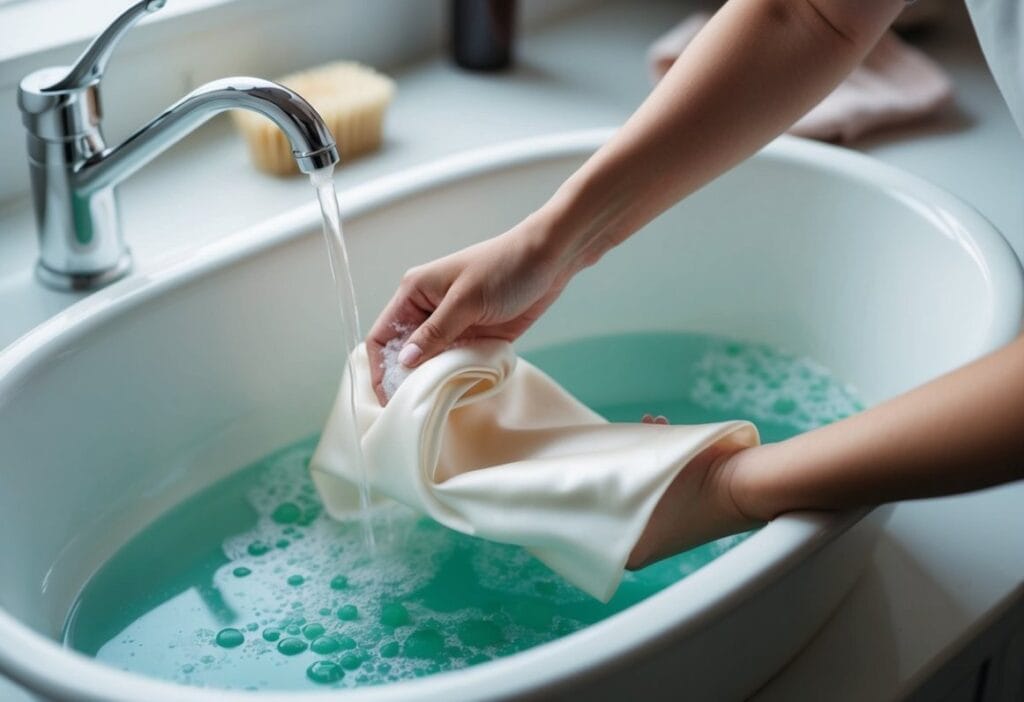Extend the Life of Your Favorite Satin Garments with Maintenance Advice and Professional Care Secrets
Satin clothing adds a touch of luxury to any wardrobe. Its smooth, glossy finish feels wonderful against the skin. But this delicate fabric needs special care to keep it looking its best.
To care for satin clothing, hand wash or use a gentle machine cycle with cold water and mild detergent. Avoid wringing or twisting the fabric, as this can damage the fibres. After washing, lay satin items flat to air dry away from direct sunlight.
Proper care extends the life of satin garments. By following a few simple steps, you can enjoy the elegance of satin for years to come. Let’s explore how to keep your satin clothing looking fabulous.
On This Page
Key Takeaways
- Gentle washing and drying methods preserve satin’s lustre
- Proper storage prevents wrinkles and damage to satin fabrics
- Regular care keeps satin clothing looking elegant for longer
Understanding Satin and Its Varieties

Satin is a versatile fabric with a smooth, lustrous surface. It comes in different types and materials, each with unique qualities.
Characteristics of Satin Fabric
Satin fabric has a shiny front and a dull back. This smooth look comes from floating yarns over multiple threads. The weave creates a soft, luxurious feel.
Satin drapes well, making it ideal for flowing garments. It’s often used in:
- Evening gowns
- Lingerie
- Bedding
- Upholstery
The fabric can be slippery and may snag easily. It requires gentle care to maintain its lustre.
Silk Satin vs Other Satin Types
Silk satin is the most luxurious type. It’s known for its softness and natural sheen. Other common satin types include:
- Polyester satin: Affordable and durable
- Nylon satin: Strong and wrinkle-resistant
- Acetate satin: Crisp with high shine
Each type has its own care needs. Silk satin is delicate and often dry-clean only. Polyester and nylon satins are more robust and easier to wash at home.
Some specialty satins include:
- Antique satin: Made with uneven yarns
- Baronet satin: Combines rayon and cotton
- Charmeuse satin: Very lightweight
Choose the right satin type based on the garment’s purpose and your care preferences.
Pre-Wash Care for Satin
Proper pre-wash care is essential for maintaining the quality and appearance of satin garments. Taking the right steps before washing helps prevent damage and ensures the fabric stays lustrous.
Checking the Care Label
Always start by examining the care label on your satin item. This small tag contains crucial information about how to properly clean and care for the fabric. Look for specific washing instructions, recommended water temperature, and any warnings about dry cleaning or ironing.
If the label says ‘dry clean only’, it’s best to follow this advice. For hand-washable satin, note the suggested water temperature and detergent type. Some labels may advise against using bleach or fabric softeners.
Don’t ignore care labels – they’re there to help you keep your satin looking its best. If the label is missing or unclear, treat the item as delicate and opt for the gentlest cleaning method.
Preparation Before Washing
Before washing satin, take steps to protect the fabric. First, turn the garment inside out to reduce friction on the shiny outer surface. This helps preserve the satin’s characteristic lustre.
Next, address any stains. For oil-based marks, apply a small amount of dish soap directly to the spot. For other stains, use a gentle, enzyme-based stain remover suitable for delicate fabrics. Dab the stain gently – don’t rub, as this can damage the fibres.
Check for loose threads or embellishments and secure them if needed. Remove any detachable parts like belts or brooches. Lastly, sort your laundry carefully. Wash satin items separately or with other delicate fabrics to prevent snags and excess friction.
Washing Satin Clothing

Proper care is key to keeping satin garments looking their best. Gentle cleaning methods and the right products help maintain satin’s lustre and prevent damage.
Selecting Detergents
Choosing the right detergent is crucial for washing satin clothes. A mild liquid detergent is best. Avoid harsh chemicals and bleach, as they can harm the delicate fibres.
Look for detergents labelled ‘gentle’ or ‘for delicates’. These are less likely to strip the fabric of its natural oils.
Fabric softeners are not recommended for satin. They can leave a residue that dulls the fabric’s sheen.
Always use cool water when washing satin. Hot water can cause shrinkage and damage.
Hand Washing vs Machine Washing
Hand washing is often the safest method for cleaning satin. Fill a basin with cool water and add a small amount of gentle detergent.
Gently swish the garment in the water. Do not wring or twist the fabric. Rinse thoroughly with cool water until all soap is removed.
For machine washing, turn satin items inside out first. This protects the shiny outer surface from abrasion.
Place satin items in a mesh laundry bag. This adds an extra layer of protection during the wash cycle.
The Delicate Cycle
When machine washing satin, always use the delicate cycle. This setting uses a slower spin speed and less agitation.
Set the water temperature to cold. Warm or hot water can damage satin fibres.
Use only a small amount of mild detergent. Too much soap can leave residue on the fabric.
After washing, remove satin items promptly from the machine. Hanging wet satin can cause stretching.
To dry, lay the garment flat on a clean towel. Reshape if needed. Avoid direct sunlight or heat, which can yellow the fabric.
Drying Satin After Washing

Proper drying is crucial for maintaining the quality and appearance of satin garments. It’s essential to handle these delicate items with care to prevent damage and preserve their lustre.
Air-Drying Satin Pieces
Air-drying is the safest method for drying satin. After washing, gently squeeze out excess water without wringing or twisting the fabric. This prevents stretching and wrinkling.
Lay the satin piece flat on a clean, dry towel. Roll the towel with the garment inside to absorb moisture. Unroll and reshape the item if needed.
Hang satin dresses and other garments on padded hangers to maintain their shape. Avoid clothes pegs, as they may leave marks on the fabric.
For smaller satin pieces, lay them flat on a drying rack or a fresh towel. Keep them away from direct sunlight and heat sources to prevent fading and damage.
Avoiding Heat Damage
Heat can be harmful to satin, causing shrinkage and loss of sheen. It’s best to avoid using a tumble dryer for satin clothes.
If you must use a dryer, select the lowest heat setting and place satin items in a mesh laundry bag. Remove them while still slightly damp to prevent over-drying and static buildup.
Never iron damp satin. Wait until the garment is completely dry. Use a cool iron setting and place a pressing cloth between the iron and the fabric to protect its surface.
Steaming is a gentle alternative to ironing. Hold the steamer a few inches away from the fabric to remove wrinkles without direct contact.
Ironing and Steaming Satin

Satin requires special care when removing wrinkles. Proper techniques help maintain the fabric’s lustrous sheen and prevent damage.
Preparing to Iron Satin
Before ironing satin, check the care label for specific instructions. Set your iron to a low heat setting, typically marked for silk or synthetic fibres. Use a pressing cloth to protect the fabric from direct heat.
Turn the satin garment inside out to iron on the reverse side. This helps preserve the shiny finish. Lay the item flat on your ironing board and smooth out wrinkles with your hands.
Fill a spray bottle with distilled water. Lightly mist the satin to dampen it slightly. This helps create steam and makes wrinkle removal easier.
Ironing Techniques for Satin
Start ironing with gentle, gliding motions. Don’t press down too hard or leave the iron in one spot for long. Move the iron constantly to prevent heat damage.
Use the steam function on your iron for best results. The extra moisture helps smooth out stubborn wrinkles. If your iron lacks this feature, periodically mist the fabric with water as you work.
For delicate satin items, try steaming instead of ironing. Hang the garment and use a handheld steamer, keeping it a few inches away from the fabric. The steam will gently release wrinkles without direct contact.
After ironing or steaming, hang the satin item immediately to prevent new wrinkles from forming. Allow it to cool and dry completely before wearing or storing.
Storing Satin Correctly

Proper storage keeps satin looking its best. The right methods prevent damage and maintain the fabric’s shine. Here are key tips for storing satin items safely.
Using Appropriate Storage Solutions
Garment bags are ideal for satin clothing. Choose breathable fabric bags over plastic to avoid trapping moisture. Hang satin dresses and blouses on padded hangers to prevent creases.
For folded items, use acid-free tissue paper between layers. This stops colour transfer and reduces friction. Store satin sheets in cool, dry places away from direct sunlight.
Avoid cramming satin items together. Give each piece space to prevent crushing. Use drawer dividers or small boxes to keep items separate.
Preventing Wrinkles and Damage
Satin wrinkles easily, so careful storage is crucial. Smooth out creases before putting items away. For long-term storage, roll satin pieces instead of folding.
Keep satin away from rough surfaces that might snag the fabric. Line drawers with soft cloth to create a smooth base. Avoid storing heavy items on top of satin clothing or bedding.
Check stored satin regularly for signs of moisture or pests. Air out items occasionally to prevent musty odours. Use cedar blocks or lavender sachets to deter moths naturally.
Spot Cleaning and Stain Removal
Proper spot cleaning and stain removal techniques are crucial for maintaining satin garments. Quick action and the right products can help preserve the fabric’s lustrous appearance.
Immediate Action for Spills
When a spill occurs on satin, act fast. Blot the area gently with a clean, white cloth to absorb excess liquid. Do not rub, as this can spread the stain and damage the delicate fibres.
For water-based stains, use cold water and a mild detergent. Apply the solution with a soft cloth, working from the outside of the stain towards the centre.
Oil-based stains require a different approach. Sprinkle talcum powder or cornstarch on the spot to absorb the oil. Let it sit for 15-30 minutes, then brush off gently.
Always test any cleaning method on an inconspicuous area first to ensure it won’t harm the fabric.
Using Specialised Stain Removal Products
For stubborn stains, specialised products can be effective. Choose a stain remover designed for delicate fabrics like satin.
- Enzyme-based stain removers work well on protein stains such as food or sweat.
- Solvent-based cleaners are better for oil or grease stains.
Apply the product sparingly with a clean cloth or cotton swab. Gently work it into the stain, being careful not to oversaturate the fabric.
After treating the stain, rinse the area thoroughly with cool water. Avoid using hot water, as it can set the stain permanently.
Let the garment air dry naturally. Do not use a dryer, as heat can damage satin fabric.
Frequently Asked Questions
Caring for satin clothing requires gentle techniques and careful attention to detail. These common queries address key aspects of washing, drying, and maintaining satin garments.
What is the best method to hand wash a satin dress?
Fill a basin with cool water and add a mild detergent. Gently submerge the dress and swish it around. Avoid rubbing or wringing the fabric. Rinse thoroughly with cool water until all soap is removed.
Can you machine wash satin clothing, and if so, how?
Some satin items can be machine washed. Use a mesh laundry bag and select the delicate cycle with cold water. Add a gentle detergent and avoid using fabric softener. Remove the garment promptly after the cycle ends.
What are the appropriate drying techniques for satin garments?
Air drying is best for satin. Lay the item flat on a clean towel away from direct sunlight. Reshape the garment while damp. Avoid hanging satin items, as this can cause stretching.
How should satin fabric be cared for to prevent damage?
Store satin items in a cool, dry place. Use padded hangers for hanging garments. Avoid high heat when ironing and place a cloth between the iron and fabric. Keep satin away from harsh chemicals and rough surfaces.
What steps are needed to remove stains from satin dresses?
Act quickly when a stain occurs. Blot the area with a clean, white cloth. Use a mixture of mild dish soap and warm water to gently dab the stain. Rinse thoroughly and air dry. For tough stains, seek professional cleaning.
Is dry cleaning a safe option for satin dresses?
Dry cleaning is often a safe and effective option for satin dresses. Inform the cleaner about the fabric type and any specific concerns. This method can help maintain the sheen and structure of satin garments.
Related Post: What You Need to Know About Satin Fabric: A Guide to Its Properties and Uses

